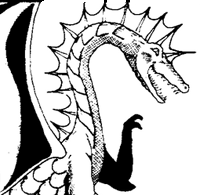 A considerable number of mythological deities are said to throw thunderbolts - Zeus and Thor are merely the most familiar of these to Europeans, with examples known from many other cultures. Actual mythic creatures that throw lightning, however, are much less common, although Chinese dragons are at least associated with thunder and storms. In D&D, however, it seems an obvious attack mode once we've dealt with fire and ice, and, naturally enough, it's associated with the dragon that's the colour of the sky.
A considerable number of mythological deities are said to throw thunderbolts - Zeus and Thor are merely the most familiar of these to Europeans, with examples known from many other cultures. Actual mythic creatures that throw lightning, however, are much less common, although Chinese dragons are at least associated with thunder and storms. In D&D, however, it seems an obvious attack mode once we've dealt with fire and ice, and, naturally enough, it's associated with the dragon that's the colour of the sky.Saturday 4 September 2021
D&D Monsters: Blue Dragons
 A considerable number of mythological deities are said to throw thunderbolts - Zeus and Thor are merely the most familiar of these to Europeans, with examples known from many other cultures. Actual mythic creatures that throw lightning, however, are much less common, although Chinese dragons are at least associated with thunder and storms. In D&D, however, it seems an obvious attack mode once we've dealt with fire and ice, and, naturally enough, it's associated with the dragon that's the colour of the sky.
A considerable number of mythological deities are said to throw thunderbolts - Zeus and Thor are merely the most familiar of these to Europeans, with examples known from many other cultures. Actual mythic creatures that throw lightning, however, are much less common, although Chinese dragons are at least associated with thunder and storms. In D&D, however, it seems an obvious attack mode once we've dealt with fire and ice, and, naturally enough, it's associated with the dragon that's the colour of the sky.Thursday 19 August 2021
D&D Monsters: White Dragons
1E
Thursday 22 July 2021
D&D Monsters: Red Dragons
In D&D, of course, it was originally decided that the five types of chromatic dragon should be distinguished by each having a unique attack, so that green dragons breathe poison, black dragons acid, and so on. Naturally, the most powerful of all the chromatic dragons was going to be the one that breathed fire, fitting the legends on which the broader idea is based.
Thursday 8 July 2021
D&D Monsters: Green Dragons
In D&D, the basilisk is quite a different creature, and very far from being legless. While the association of poison with serpentine beings make sense, it's not common in depictions of dragons. The D&D idea of certain dragons belching poisonous gas instead of something flammable is likely an original one - something added so that each of the five chromatic dragons had a unique attack mode. And in this case, of course, that's the green dragon, the mid-point in the five-point scale of increasing chromatic dragon power.
Thursday 1 July 2021
D&D Monsters: Black Dragons
Given that they're right there in the name of the game, dragons are obviously fairly key to D&D. In the 1st edition, they receive more detailed options than other monsters, having eight age categories and three size classes, and a suite of special abilities right from the beginning. Furthermore, there are no less than ten different kinds of true dragon, divided evenly between the good 'metallic' and the evil 'chromatic' species.
Tuesday 22 June 2021
D&D Monsters: Wyverns
When Gygax adopted the term for D&D, he made wyverns somewhat weaker than true dragons, and unable to breathe fire. Traditional illustrations often show two-legged dragons with snake-like tails ending in a sharp point, and this became the poison stinger seen in D&D. Perhaps following on from this, there has been a tendency in fantasy fiction to make wyverns weaker than four-legged dragons, although that's perhaps turning round again more recently - in both the books and TV series, for instance, the fire-breathing and deadly dragons of Game of Thrones only have two legs.
Tuesday 8 June 2021
D&D Monsters: Carrion Crawlers and Purple Worms
 The majority of giant invertebrate monsters in the early editions of D&D are, at least in general terms, arthropods - the group of jointed-limbed creatures with chitinous exoskeletons to which insects, spiders, and crabs belong, among others. Exceptions include giant octopuses and giant squid, which are at least partially based on real animals, a few aberrations that are difficult to ally with anything real, and, somewhere in between, the purple worm. As originally drawn, the carrion crawler also qualifies, although this changes in later editions.
The majority of giant invertebrate monsters in the early editions of D&D are, at least in general terms, arthropods - the group of jointed-limbed creatures with chitinous exoskeletons to which insects, spiders, and crabs belong, among others. Exceptions include giant octopuses and giant squid, which are at least partially based on real animals, a few aberrations that are difficult to ally with anything real, and, somewhere in between, the purple worm. As originally drawn, the carrion crawler also qualifies, although this changes in later editions.The worm-like body plan is a common one among real-world invertebrates, being found in a wide range of creatures that aren't all that closely related. But, on the whole, they aren't very fearsome, and the different types don't have the recognisability factor that spiders, scorpions, praying mantises, or whatever, might have. Even in D&D, the primary threat from the purple worm comes from the fact that it's just really big. The carrion crawler is a different matter, but, then it is rather less wormlike. Both creatures have 'Ronseal' style names, although, at least to my mind, 'carrion crawler' is, like 'mind flayer', one of the more evocative ones.




